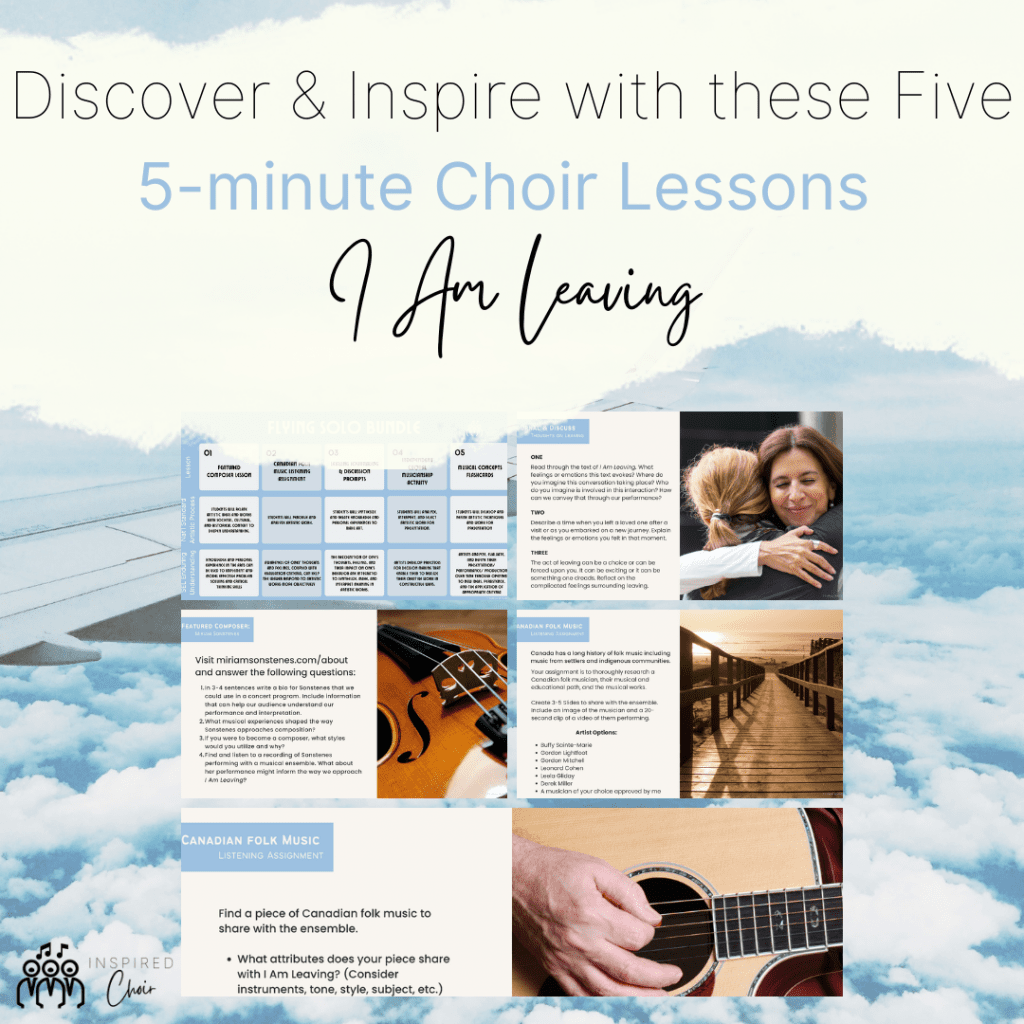The Inspiration and Influences behind Miriam Sonstenes’s I Am Leaving
With a sweet, simple melody, accessible harmonies, and a thought-provoking message, I Am Leaving by Miriam Sonstenes is a great choice for developing choral ensembles. Available for SAB or SSA voicings, the piece introduces choirs to a variety of musical concepts and inspires discussions about the challenges of leaving. Below is an in-depth guide to I Am Leaving including:
- Featured Composer: Miriam Sonstenes
- Canadian Folk Music that Inspires
- Feelings about Leaving
- Freedom in I Am Leaving
- I Am Leaving’s Musical Concepts
- I Am Leaving Teacher Resources
- …and so much more!
Beginning of the Year Simplicity Vibes
Sometimes you just need to start simple. Maybe it’s the beginning of the year; maybe you want to focus on skill building; or maybe you need a simple contrast to the rest of your program. Miriam Sonstenes’s I Am Leaving brings us those simple vibes while building choral skills and packing an emotional punch through its message. Listen to the piece here.
Our A-State treble ensemble will be studying the SSA arrangement of the piece this fall for their “Roots” concert. (I talked a bit about the concert theme in this post). The lyrics of the piece depict the feeling of leaving loved ones following precious time spent together. These short visits can “root” us to our families, friends, those for whom we care. The sweet, rubato nature of the piece reminds me of those lingering moments as we say goodbye over and over again before we actually leave. (Midwest Goodbye Anyone?)

Listen, Plan, and Discuss with I Am Leaving
I Am Leaving appears simple – not only in its notes and rhythms, but also in its lyrics and message. Simple shouldn’t make singers shy away, though! As we dive deeper into the stylistic expectations, musical concepts, and emotional responses, we can find so much meaning in the simplicity.
Let’s Talk about Composer Miriam Sonstenes
According to her website, Miriam Sonstenes grew up listening to folk music. Her early music education included violin and piano lessons and she trained as a classical musician at the Vancouver Academy of Music and University of Victoria.
Sonstenes’s training in fiddle music of all kinds began following her formal training. Her current playing is inspired by roots music from Ireland and Appalachia, as well as swing and bluegrass. By traveling and studying and performing with a variety of roots and folk artists, Sonstenes has become well-acquainted with many fiddle traditions.
The composer performs with folk groups Old Paint Duo, The Sweet Lowdown, and The Unfaithful Servants. Additionally, Sonstenes teaches violin, fiddle, banjo, guitar, and piano; teaches at music camps and workshops; and adjudicates at festivals.
So far, it appears that I Am Leaving is Sonstenes’s only work for choirs. However, you can listen to her roots and folk groups perform some of her compositions here. As I talked about in my Vichten post, listening is key to learning and understanding folk music. Perhaps listening to Sonsenes’s works for folk and roots groups could lend itself to understanding the nature and intention of I Am Leaving.

Canadian Folk Music that Inspires
Who knew Canada had such a thriving folk music scene? (A lot of Canadians I bet…). Exploring this scene can help us to understand the origins of I Am Leaving just a little bit better.
Canadian folk music is derived from music of indigenous communities and 16th and 17th century settlers as well as from the many immigrant communities who have made Canada their home. Seminal folk musicians from Canada include Buffy Sainte-Marie, Joni Mitchell, Leonard Cohen, Gordon Lightfoot, Neil Young, and Stan Rogers.
Song types include songs of sea, love songs, lullabies, game songs, drinking songs, mouth music (like that of Vichten), and songs about the old country. String instruments, especially the fiddle, are often featured in Canadian folk music. In rural areas, Franco- and Anglo-Canadian folk music are predominant, however in the more urban areas, folk music of more recently settled cultural communities are flourishing.
Our featured composer, Miriam Sonstenes, is one of many contemporary Canadian folk musicians who perform, teach, and tour. As I write, I am listening to this playlist of contemporary Canadian folk – take a listen!
How Does Leaving Make You Feel?
According to the publisher of the I Am Leaving, the piece is about “the challenges of having family far away, and the visits which are so precious are never long enough.” Singers and listeners of all ages can easily identify with the feelings associated with these challenges.
Leaving can evoke powerful emotions, and this piece allows us to channel those emotions through a simple melody and comforting harmonies. Sometimes these emotions can be complicated – especially when we don’t choose to or want to leave. The lyrics of I Am Leaving work through these complications: holding on to sweet memories, singing a song to dry tears, redirecting focus to the the stars, it won’t be long.
When performing this piece, it is important to tap into these complicated feelings. Which goodbye are you channeling? Who are you singing to? Is this a sweet or bitter goodbye? How will you convey these emotions to your audience? Singing and emoting with intentionality can take a performance to the next level.
Freedom in I Am Leaving: Pass off the reigns
Many folk ensembles are all about collaboration. Participants in the ensemble pass the lead often, either with singing or instrumentation. Unless the band tells them outright, the audience likely doesn’t know who the “leader” of the group is.
With this in mind, I have a challenge for you, choir directors. As you are able, give your singers freedom with this piece. Let them make some decisions (even if you don’t like their choices) with interpretation of I Am Leaving. Not only will this promote skills for life-long musicianship, it hits on our National Standards Artistic Process “Develop and refine artistic techniques and work for presentation.”
Here are a few ideas of decisions the choir could make about I Am Leaving:
- The piece starts “freely” – what does this mean?
- There are no dynamics indicated in this octavo. How should we approach dynamics?
- How should we interpret the fermatas at the end of each phrase?
- What musical decisions can we make to keep interest throughout the repetition of this piece?
- If you have a two-part ensemble: How can we re-arrange this piece for 2 parts and solos?
- How can we re-arrange this piece to move the melody around the choir?
- What standing arrangement would serve this piece best?
- Can we perform this piece without a conductor? What communication will we need to do this successfully?

I Am Leaving Musical Concepts
Sometimes it’s a little bit easier to grasp on to traditional music theory concepts when you see them in context. Here are a few musical concepts you may come across as you study this piece:
- Triple Meter: a musical meter with 3 beats per measure (e.g. 3/4 or 9/8)
- Fermata (𝄐): hold until the conductor indicates to move on
- Slur: play notes within the slur without separation. Denoted by a curved line connecting two or more notes of different pitches.
- Musical Form: the structure or larger shape of a musical composition
- Verse-Chorus Form (aka verse-refrain form): a musical structure with two repeating sections: a verse section and a chorus section
- Strophic Form: a musical structure with the same music for every verse
- poco rit.: short for poco ritardando – to slow down a little bit
Complimentary Pieces
Want to listen to other pieces like I Am Leaving? Or planning a concert and need some programming ideas? Here are a few complementary pieces!
Loving the North American Bluegrass vibe?
- Susan Labarr’s The River is a thoughtful and reflective piece that allows tenor and bass singers an opportunity to consider the places that set the foundation for their lives as they sing about a man’s connection to his boyhood river.
- A-State choirs performed Carol Barnett’s Bluegrass Mass last year with bluegrass group Monroe Crossing and it was such a cool experience. Definitely a challenge, but once you add the band, it’s magic. Available to purchase as the whole mass or in individual movements.
- How about a little Mountain Music arranged by Mac Huff? Randy Owen’s bluegrass tune is available for SATB, SAB, and two-part ensembles.
A few of the other “roots” themed pieces I’m pairing with I Am Leaving this concert cycle:
- Ysaye M. Barnwell’sWanting Memories
- Hart Rouge’s Vichten
- Reena Esmail’s TāReKiTa
- The full “Singing Our Roots” program round-up

I’d Love to Hear from You!
Have you sung or conducted I Am Leaving with your choir? What stories of leaving were you able to connect with this piece? How did you make the repetitions unique? Were you able to take or share some ownership of the piece? Let me know in the comments section below!
I Am Leaving Teacher Resources
Free Comprehension Worksheets
Choir Leaders! I have begun to include short comprehension worksheets with each Inspired Choir blog post. Each worksheet includes 5-6 knowledge-based questions about the post and concludes with a musical decisions/applications question. Use as a homework assignment, sub activity, listening challenge, or guide for conversation in class. Fill in the form below to receive a link immediately to all “Roots” Worksheets.
I Am Leaving Lesson Plan Bundle
Check out the Inspired Choir Shop for the I Am Leaving Lesson Plan Bundle. This bundle includes the following five minute lesson plans, all with connections to National Standards and SEL Competencies:
- Featured Composer Bell Ringer
- Canadian Folk Music Listening Assignment (Two Options!)
- Leaving Journaling & Discussion Prompts
- Independent Choral Musicianship Activity
- Musical Concepts Flashcards


















